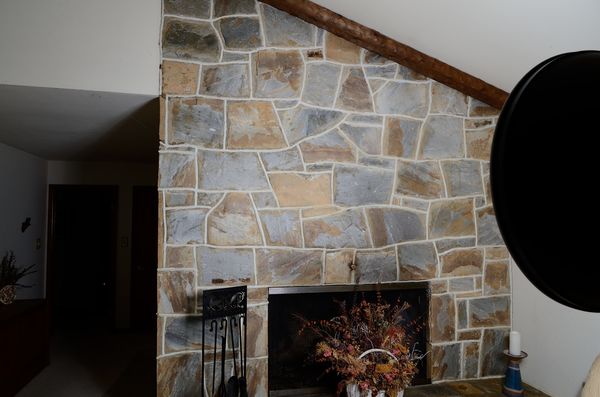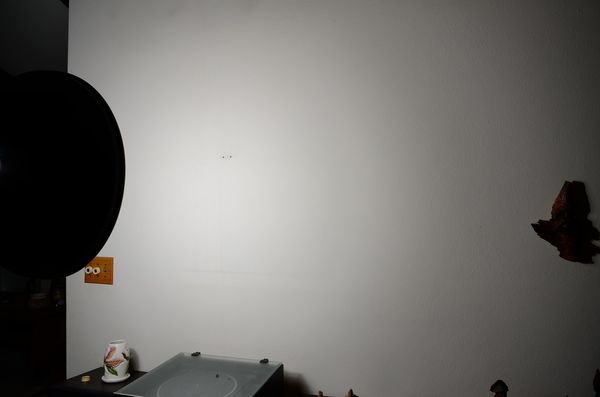Beauty dish
Nov 26, 2017 14:19:27 #
Interested in purchasing a beauty dish. 22" vs 28", mostly photographing 1 or 2 subjects, will 22" be enough? Thank you
Nov 26, 2017 16:16:42 #
I have a Paul C. Buff 22" white beauty dish. It easily has enough coverage (130 degree beam spread). They have a formula on their website for calculating the coverage. The coverage is 2.14 times the distance between the dish and subject. Their silver beauty dish has a much narrower beam spread (45 degrees). The coverage for that dish is .83 times the distance between the dish and subject. I was doing some test shots when I first got it. You can see the dish on the right side. The distance between it and the fireplace is about 8 feet there. In the lower photo the dish was 2-1/2 feet from the wall. I actually measured the distance with a tape measure. I did a series of photos like this because I wanted to see if the center direct light blocker disc would create a darker central area. I didn't see that the central area was any darker than the outer portions.
I don't have experience with any other beauty dishes. It's possible that you can get coverage information from the manufacturers of the two beauty dishes you're looking at.
I don't have experience with any other beauty dishes. It's possible that you can get coverage information from the manufacturers of the two beauty dishes you're looking at.
Nov 27, 2017 00:10:37 #
Nov 27, 2017 06:37:43 #
Metpin777 wrote:
Interested in purchasing a beauty dish. 22" vs 28", mostly photographing 1 or 2 subjects, will 22" be enough? Thank you
Whenever I hear that term, I think the model must smile when he/she hears that the photographer is bringing out the Beauty Dish.

Nov 27, 2017 07:31:17 #
jerryc41 wrote:
Whenever I hear that term, I think the model must smile when he/she hears that the photographer is bringing out the Beauty Dish. 

That's a good one Jerry lol.
Nov 27, 2017 13:27:46 #
SIZE COUNTS but distance is just as important. With any conventional photographic light source, that is one equipped with a parabolic reflector or a pan or dish type reflector with a center deflector (AKA "beauty dish") the degree of softness or evenness of the beam is greatly depended on the distance that the light source is placed from the subject. For head and shoulder, closeup and small group portraiture, where the main light will be placeed between 3 and 5 feet from the subject(s) a smaller dish or even a 16" feathered parabolic will do the trick. For full length portraits, larger groups or any scenario where the main light may be placed between 8 to 12 away from the subject(s) a larger dish or other modifier is recommended to maintain the same degree of softness and even spread of light that a closer distanced affords.
What many photographers, who are new to lighting theory, fail to realize that even a very large modifier like a giant umbrella is not all that soft and even at very far working distances.
Sometimes, a "beauty dish" ain't all the beautiful- well, it does not automatically provide a glamorizing or dramatic lighting. The basic concept of the beauty dish is the central deflector eliminates the so-called hot spot, however, a basic parabolic reflector with a hot spot and a certain degree of fall off at the edges enable FEATHERING, that is using the EDGE of the beam rather than the hot spot. This method reveals a natural skin texture and is compatible with many classical lighting forms such as "Rembrandt", butterfly, modified butterfly (loop) and split as well as hair and kicker lighting. This kind of unmodified parabolic lighting requires a more precise lighting placement and keen observation of the lighting's effect highlight and shadow placement and the subject's facial structure.
Many of the classical "Hollywood" portrait stylings were done with feathered parabolic or SPOT lighting.
Ain't nothin' wrong with a beauty dish. Besides portraiture, it's even beam can also be uses as a fill light source, for certain still life and product shots and interior architectural work.
Nowadays there are so many reflector configurations, light modifiers, bounce umbrellas, shoot-through umbrellas, soft-boxes, octo-boxes, scrims that are fitted to umbrellas and beauty dishes, hybrid soft-box/umbrella/ beauty dishes etc- it's enough to drive someone nuts! Each manufacturer touts their's as the best, the latest and the revolutionary one. If, however, you understand your lighting principles as to, to feather or not to feather, to use you hot spot or eliminate it, and the softness/distance effect and you study your ANGEL OF INCIDENCE theory you will easily cut through the confusion. If you have a medium sized beauty dish you can pop off the deflector and do some feathering. You can simulate many kinds of modification effects by varying the distance from you primarily light source to your umbrella surface.
Over the years, I have collected enough reflectors and modifiers to fill a warehouse. Many of them just wore out from hard use and needed to be replaced. Others were used for specific jobs like very slim soft boxes to light wine bottles (etc) and doubled as hair lights for group portraits. At the end of the day, I do most of my studio work with 3 modifiers and one set of dirty old parabolic reflectors and barn doors. Saves money!
What many photographers, who are new to lighting theory, fail to realize that even a very large modifier like a giant umbrella is not all that soft and even at very far working distances.
Sometimes, a "beauty dish" ain't all the beautiful- well, it does not automatically provide a glamorizing or dramatic lighting. The basic concept of the beauty dish is the central deflector eliminates the so-called hot spot, however, a basic parabolic reflector with a hot spot and a certain degree of fall off at the edges enable FEATHERING, that is using the EDGE of the beam rather than the hot spot. This method reveals a natural skin texture and is compatible with many classical lighting forms such as "Rembrandt", butterfly, modified butterfly (loop) and split as well as hair and kicker lighting. This kind of unmodified parabolic lighting requires a more precise lighting placement and keen observation of the lighting's effect highlight and shadow placement and the subject's facial structure.
Many of the classical "Hollywood" portrait stylings were done with feathered parabolic or SPOT lighting.
Ain't nothin' wrong with a beauty dish. Besides portraiture, it's even beam can also be uses as a fill light source, for certain still life and product shots and interior architectural work.
Nowadays there are so many reflector configurations, light modifiers, bounce umbrellas, shoot-through umbrellas, soft-boxes, octo-boxes, scrims that are fitted to umbrellas and beauty dishes, hybrid soft-box/umbrella/ beauty dishes etc- it's enough to drive someone nuts! Each manufacturer touts their's as the best, the latest and the revolutionary one. If, however, you understand your lighting principles as to, to feather or not to feather, to use you hot spot or eliminate it, and the softness/distance effect and you study your ANGEL OF INCIDENCE theory you will easily cut through the confusion. If you have a medium sized beauty dish you can pop off the deflector and do some feathering. You can simulate many kinds of modification effects by varying the distance from you primarily light source to your umbrella surface.
Over the years, I have collected enough reflectors and modifiers to fill a warehouse. Many of them just wore out from hard use and needed to be replaced. Others were used for specific jobs like very slim soft boxes to light wine bottles (etc) and doubled as hair lights for group portraits. At the end of the day, I do most of my studio work with 3 modifiers and one set of dirty old parabolic reflectors and barn doors. Saves money!
Nov 29, 2017 07:52:40 #
jerryc41 wrote:
Whenever I hear that term, I think the model must smile when he/she hears that the photographer is bringing out the Beauty Dish. 

Lmao, thats funny
Nov 29, 2017 07:55:07 #
E.L.. Shapiro wrote:
SIZE COUNTS but distance is just as important. Wit... (show quote)
Very useful info, learning basics with OCF, thank you
If you want to reply, then register here. Registration is free and your account is created instantly, so you can post right away.





